Competitive analysis: how-to, tools and examples
Aug 1st, 2023

Contents
What is competitive analysis?
How to conduct a competitive analysis?
Tools for competitive analysis
Competitive analysis examples
Delivering excellent customer service and creating long-lasting relationships with clients are the primary goals of marketing. Businesses can accomplish this by developing a competitive edge, a substantial long-term advantage. But first, you need to identify your rivals, examine their products and services and determine how to differentiate your offering from similar ones on the market.
Understanding your rivals is critical for your company’s success if you are a business owner, startup founder, product developer, or marketer. Competitive analysis will be useful in this matter. Conducting this type of study at any stage of your business is worthwhile. It is a highly effective tool for developing a strategy that makes your business prosper.
What is competitive analysis?
Competitive analysis is the process of studying competitors in your industry to learn more about their marketing techniques, sales, products, and branding. With this data, you can identify your product’s strong and weak points, evaluate your current strategy and make business decisions.
The main objectives of competitive analysis include determining the strongest competitors, analyzing their strategies, predicting their reactions based on your actions, and influencing their decisions in your favor. Besides this, a competitor analysis provides several benefits, including discovering unexplored niche markets, meeting client needs better than rivals, and determining industry standards to satisfy and outperform them. Moreover, it can help you create a unique value proposition and differentiate your offering from competitors.
By comparing your performance to the top players in your industry, you can find areas for improvement and uncover strategies that could work with maximum efficiency. Moreover, with competitive analysis, you can establish performance benchmarks for your company and come up with ideas for new posts. You can also find ways to differentiate your brand from the rivals and understand how to communicate with your audience on specific platforms.
The results of competitive analysis greatly depend on the effort invested. You can create a one-time social media competitor report or hire a market research analyst whose primary responsibility is to monitor your rivals. Most companies prefer to create quarterly or monthly reports. The insights will be priceless, regardless of the level of analysis you choose.
How to conduct a competitive analysis?
It might take time to decide where to focus your competitive analysis efforts. First, think about the purpose of your analysis before you start. Then include additional areas of research that align with those objectives. So let us dive into the process of competitive analysis, which consists of nine steps.
Step 1. Identify your competitors
The first step is to run primary research on your competitors to learn more about them. You can start by googling your product name and category and analyzing the results. The other method is to survey or interview existing clients and ask them about the alternative options they considered before choosing your product or service.
Any company or person selling an identical product or service qualifies as your rival. Moreover, your competitors serve the same target market as you do. You might decide to add businesses that are significantly larger or smaller than yours. However, if you have many rivals, concentrate mainly on those that are the same size as you. These competitors may share similar characteristics with your company, such as market share, business strategy, operational procedures, products, and services.
Using the acquired info, list ten businesses whose products are most similar to yours. Then divide them into three categories: direct competitors, indirect competitors, and replacement competitors. Direct rivals serve comparable target markets by offering similar products. Indirect competitors market to your target audience while providing a different product or service in the same category. Replacement rivals operate outside your product category but meet comparable customer needs.
Step 2. Make a competitor matrix
Before taking the next steps, you need to arrange the information. You may organize your research using a table or spreadsheet called a competitor matrix. As a result, it will be simpler to compare your results to those of rivals and see broader patterns.
Devote one column or row to each competitor you’ve chosen. List the data points or categories on the other axis. If you are not sure what categories to add or what to focus on, do not worry. You can always include more categories throughout the study.
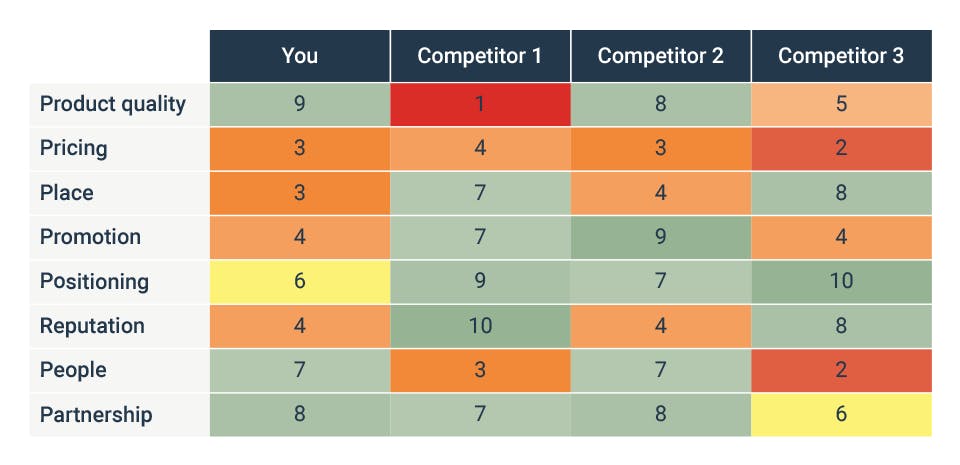
When evaluating competitors’ activities, generate a grade for each area of your qualitative research. You can also use different colors to illustrate various degrees. Start by giving your rivals a score between 1 and 10 based on the factors we will describe further in this article.
Step 3. Collect background information
Gather background information about your rivals. Check their social media pages, official websites and search for news articles about them. Review the company history, information about the founding date, funding, and acquisitions or mergers. The About section of their website or past news releases from the business are excellent sources to find data.
Then you should pay attention to the company size in terms of employees and leaders. Visit LinkedIn, Indeed, and Glassdoor to find the job openings your competitors list on these websites. In addition, you should research the number of clients and the amount of revenue the companies generate.
It is also essential to gather data about your competitors’ locations and points of sale. For example, if you are an e-commerce company, you can face competition from businesses that market their goods internationally. Conversely, your competition is probably local or regional if you operate a brick-and-mortar firm.
Step 4. Examine the competitors’ target market
You may learn a lot about the other players in the industry by gaining an understanding of their customers. Therefore, you need to take a look at their mission statement, analyze their content and messaging and monitor their social media interactions. Furthermore, you may consider the different audience segments your rivals target and how they tailor their marketing messages to each one.
Read social media reviews, comments, and discussions to understand whether your competitors meet target market expectations. In addition, you need to analyze their customers’ profiles to create buyer personas. Research the details, including age, location, occupation, income, and other demographic information.
Step 5. Analyze competitors’ products
The following step is to evaluate the competitors’ product lines and the quality of their products. Ideally, you should buy and use their products to estimate their features and characteristics. Think what it is about their products and services that appeals most to customers. Consider the weak points of their offerings.
Examine the value propositions of competitors’ products. A value proposition is a brief statement highlighting the product’s advantages and why a buyer should choose it over rival offerings. Examine the website copy of your main rivals, paying particular attention to the About and What We Do sections, as well as any blog posts and stories they may have published.
Then consider what problems and pain points rivals’ product addresses, what needs it satisfies, and what advantages and results it provides customers. Analyze their citations and other data they use to back up their claims regarding the benefits of their products.
Step 6. Research competitors’ pricing
The information about rivals’ pricing will be helpful for you in developing your pricing strategy. If you believe your product provides better features than competitors’ offerings, you can set higher prices than industry standards. Otherwise, if you notice a need for affordable products in the market, you may set a lesser price than rivals to attract another customer segment.
Therefore, you should evaluate competitors’ pricing and analyze how it reflects their products’ actual or perceived quality. Examine rivals’ pricing models and consider whether they offer a transactional or a subscription approach. Consider any benefits competition may provide and how you can respond by matching or exceeding those competitive advantages. For example, if your competitors propose a significant referral discount or a free trial period for one month, explore unique benefits your company can offer instead.
Step 7. Evaluate competitors’ marketing strategies
Analyze the market positioning of rivals. It will enable you to develop a marketing strategy that presents your brand to your target market. Pay attention to the elements and features of the products or services they emphasize. Analyze how they talk about their brand, what type of positioning, and what words, phrases, and tone your competitors use in their messaging. Think about the values they try to convey through their messages. Evaluate the visual elements of the company’s branding and consider what emotions they evoke in customers and how they correspond to the brand’s values, personality, and voice.
Consider their digital and traditional advertising presence. Look at what advertising channels they use to publish organic content, including social networks, blogs, landing pages, and email. Take into account the types of content rivals use, such as articles, explainer videos, ebooks, white papers, case studies, and infographics.
Check what social media influencers the companies collaborate with to appeal to the target audience. Examine whether your competitors involve any brand ambassadors and use referral programs to collect more customer recommendations.
Step 8. Study their content and audience engagement
Now you need to determine how frequently your competitors publish their content and analyze the quality of their articles and the topics they discuss. Choose several pieces instead of reading every publication to make the procedure more manageable. To obtain a good idea of what your rivals share with their target audience, your selection of articles should contain information on different subjects.
Then examine content accuracy, tone, and readability. Look at keywords your competitors focus on and consider the ones you haven't used yet. Find the content that has received the most shares and links. In addition, pay attention to the images and photographs your rivals use.
Further, you should evaluate how rivals’ target audience reacts to their content and estimate the level of engagement. You need to look at customer reviews, responses, and comments on social networks, check social media mentions, and find employee feedback on job websites. Pay attention to the number of followers on social media, content virality, and topics that are more appealing than others. Based on product reviews, social media likes, and mentions, what is the general public's opinion about this company? Take into account both positive comments and complaints.
Step 9. Perform a SWOT analysis
The final step of a competitive analysis is to identify strengths, weaknesses, opportunities, and threats. Consider the reasons why customers choose a certain brand's products or services over other options. Think about strengths and advantages related to products, brand management, marketing, and customer journeys. Evaluate the weakest point of your competitors where your brand has a competitive advantage. Then analyze the opportunities your company can capitalize on. Take into consideration the actions taken by your rivals that might pose a threat to your business.
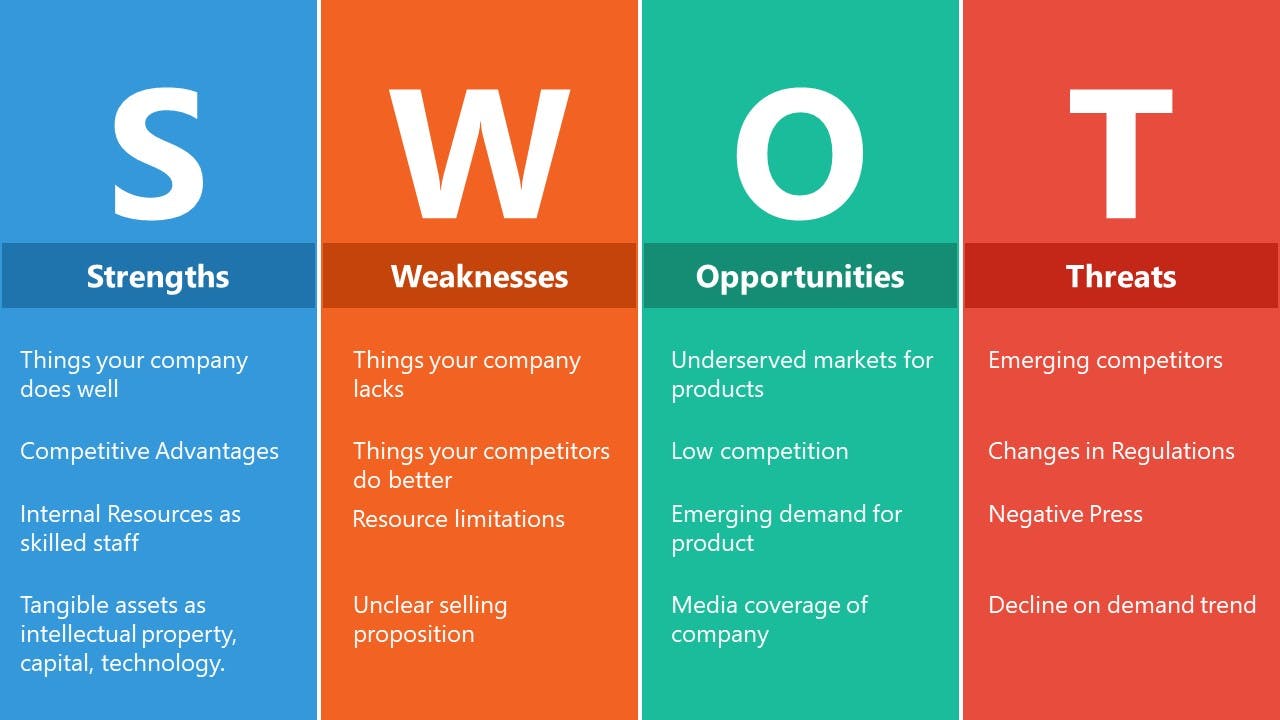
Finally, think about the positive and negative aspects of your own business. What advantages does your company have over the rivals you have researched? You can better serve your target clients by knowing what makes your company stand out from the competition and what areas need improvement.
Once you have estimated each component in your competitive analysis, it is time to learn more about the tools that can help streamline the process.
Tools for competitive analysis
You may learn more about your competition's advertising strategies and the factors that contributed to their success by using rival analysis tools, such as programs or mobile applications. It is crucial to ensure that the tools for competitive analysis are within your budget, provide the specific information you are looking for, and allow you to monitor several competitors simultaneously.
Ahrefs
Ahrefs is a valuable tool for your company if you need to gather reliable data about your competitors’ paid and organic traffic. This tool provides information about the keywords, PPC advertisements, backlinks, and competitors’ content. With its help, you can create content marketing, SEO, and PPC strategy.
Ahrefs offers a more precise view of organic traffic than other tools since it has an extensive database of over 150 million keywords. Ahrefs’ Content Gap feature shows the keywords for which your rivals rank, but you don’t. With this feature, you may easily generate a ton of fresh ideas for your content strategy. Moreover, you can use the Pages report to determine which pages of your rivals generate the most backlinks.
SpyFu
This analytics tool helps you learn more about your competitors’ paid traffic. You may use the tool to check which paid keywords your rivals rank now and ranked for in the past. With SpyFu, you can get practical insights into competitors’ organic and PPC strategies and find keywords for future content. If you type in your domain, the tool automatically adds the competitors most suitable for your keyword research.
SpyFu is quite simple to use, and it also provides tutorials that thoroughly explain all of its functions. It's a great tool for keyword research but also handy for competitor analysis.
Crayon
It takes a lot of time to collect and prioritize information about competitors manually. Crayon automates and simplifies the process of gathering and organizing data. With this tool, you can track more than 100 types of data related to your rivals.
Crayon collects and analyzes every data point it comes across using artificial intelligence. Companies use this tool to evaluate external messaging and positioning, product and pricing changes, marketing campaigns, and go-to-market strategies. You can receive word clouds to understand rivals’ messaging and get updates on your progress.
SimilarWeb
SimilarWeb is an analytics tool that can help identify new rivals and understand the tactics they use to succeed in the market. It is a unique tool to compare website traffic, track your performance, and check how your results correspond to those of your rivals. It can give you a better understanding of your position compared to other brands.
It reveals the current state of your company's customer base and marketing strategies. Additionally, it provides insight into your audience and the niche market from which they are coming. SimilarWeb features include SEO analysis, measuring engagement, determining the entry and exit pages, estimating bounce rate, and visualizing the funnel.
There are more excellent competitor analysis tools available than just these ones, so have a look. If you already use a social media management tool, check its features once again. Most software products in this category include some built-in data collection tools that you may utilize for your market research.
Competitive analysis examples
To illustrate how to perform competitive analysis in practice, we will provide three examples. Keep in mind that the type of information you need to collect predominantly depends on your market and product.
Mapping platform
Imagine that you want to launch a navigation or mapping platform. Your primary rivals are Apple Maps, Google Maps, and Waze, which is currently owned by Google. You want to add a feature to let users report traffic-related issues, such as road closures or accidents.
Although this product competes with other free alternatives, you should also evaluate pricing details. Pay attention to the methods your rivals use to promote their products and try to determine the audience they target, taking into account their tone. The last section of the table compares strengths and weaknesses that can help you develop a product and shape your advertising and sales communications.

In this example, Google uses verbs like “discover the world” to provide users with an experience rather than a product. The company highlights a number of its distinctive qualities, such as accessibility on a variety of devices. On the other hand, Waze presents itself in a much more straightforward manner and stresses that the software is "community-based." You may learn about the target market for each product and the attributes that are most important to them from the marketing materials.
The second table examines a certain feature more thoroughly. Sign up for a free trial of your competitor's service to test it out, and then list all the ways it works. If your rivals do not have a feature you want to offer, check whether they provide some other solutions to accomplish the same task. You may have found a brilliant product idea for an unexplored or underserved market sector if you can't discover rivals that provide this feature. However, it can also indicate that your rivals' research has led them to conclude that there is no market demand for the feature.
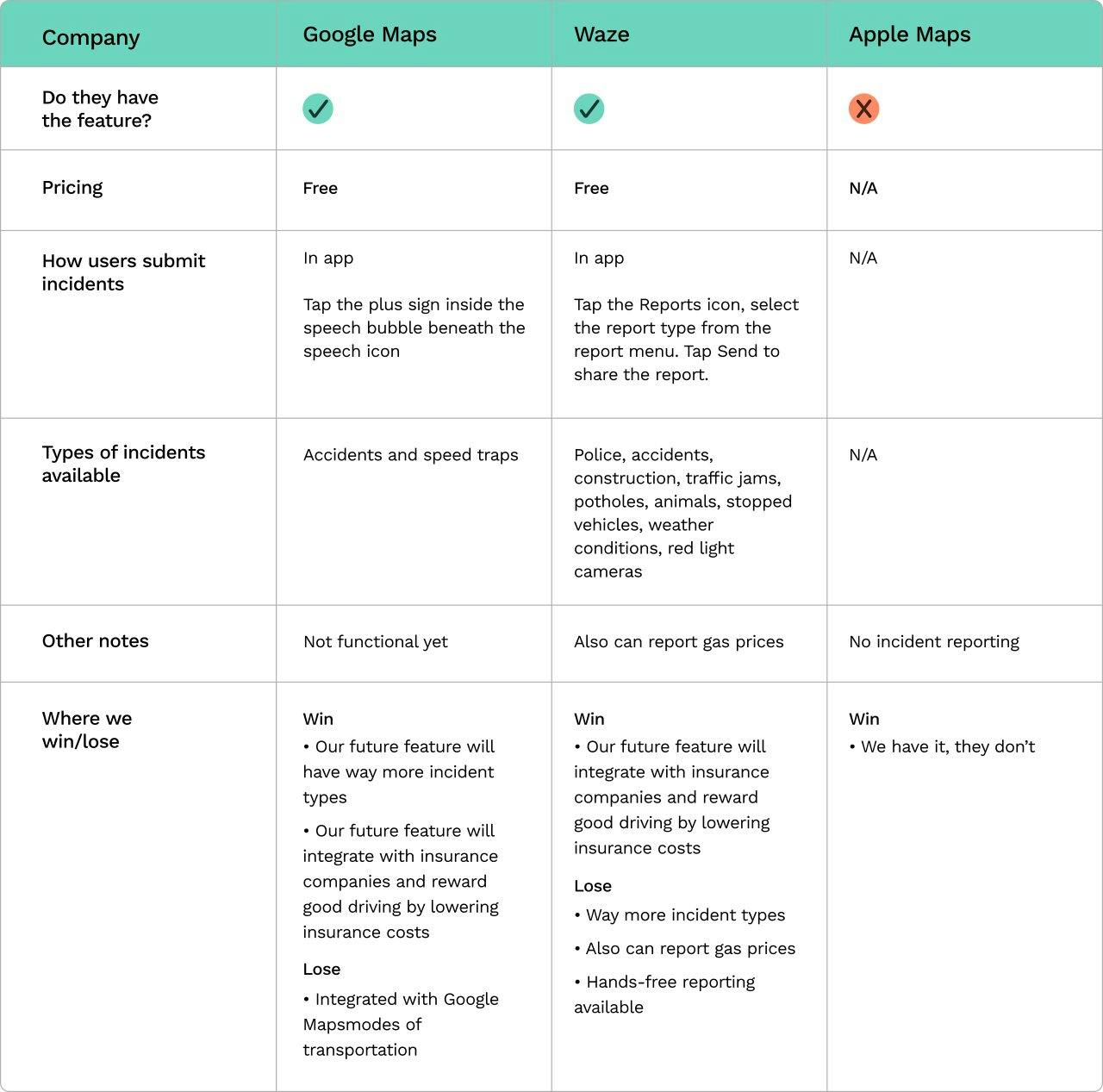
Email marketing service
The following example illustrates the comparison of various email marketing platforms. Here we compare the product called Logingo with other similar services. The table presents the best feature of each product that differentiates it from the competition. By analyzing these features, you can develop your unique selling proposition and decide what to emphasize the most in your sales and marketing materials.
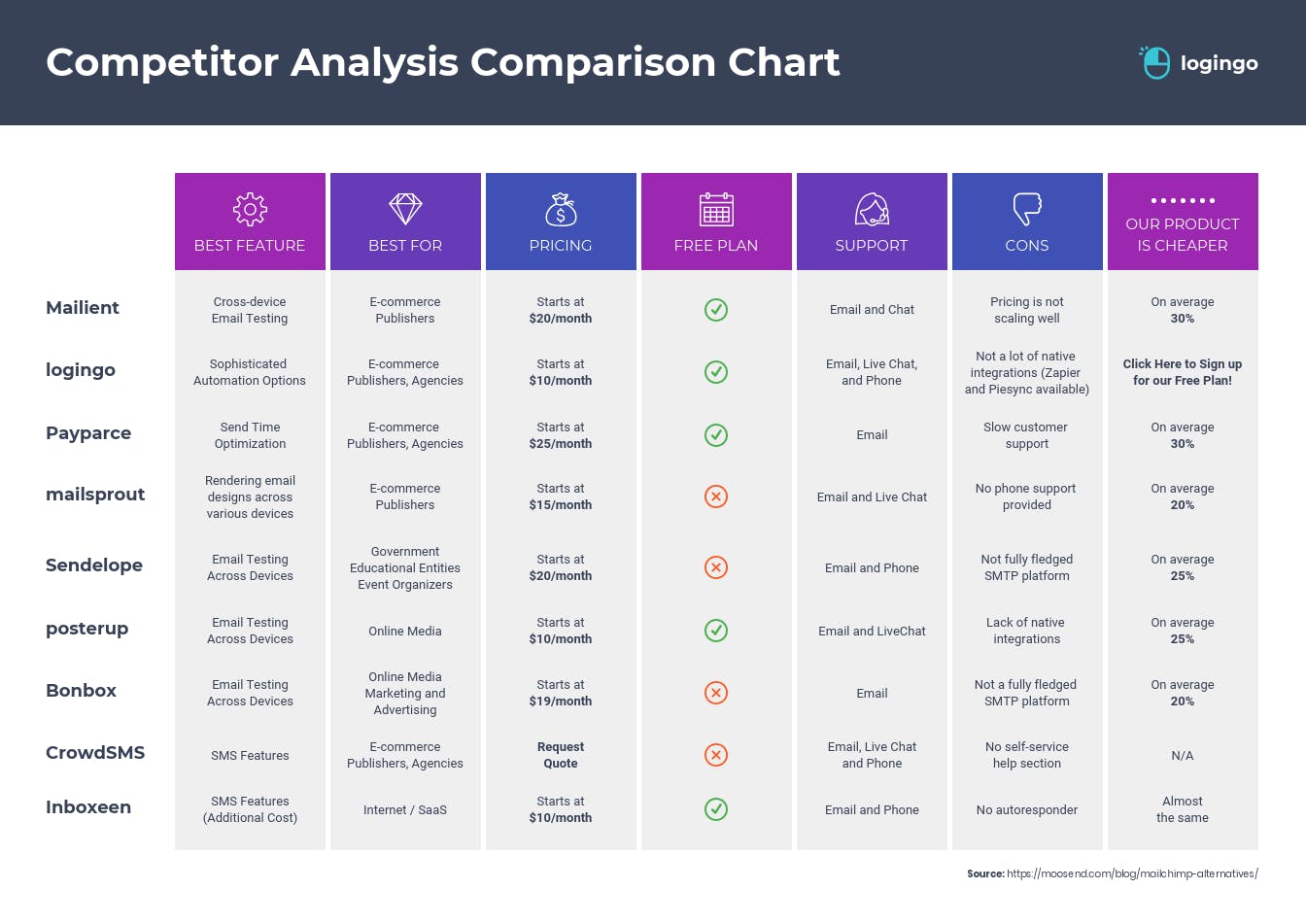
This competitive analysis table also presents the target audience for each product and compares pricing. You may note that some of these platforms offer free plans while others don’t. In addition, some of the products use multiple customer support channels, and others use only email.
The section with Cons demonstrates weaknesses of rival’s products and customers’ pain points. If the audience is price-sensitive, the last section illustrates the advantages of the product we analyzed compared to the alternatives in terms of price. Therefore, you can use all the collected information in your favor and turn it into a competitive advantage.
Flower shop
In the last example, we will compare the floral shop Fleurs Flowers with its three competitors: FromYouFlowers, Lidl, and Valentino Flowershop. It is vital to note that FromYouFlowers and Valentino Flowershop are the company’s direct competitors as they focus solely on flowers. At the same time, Lidl is a replacement competitor as it is a grocery store that offers various products besides flowers. The target audience for these businesses is the same.
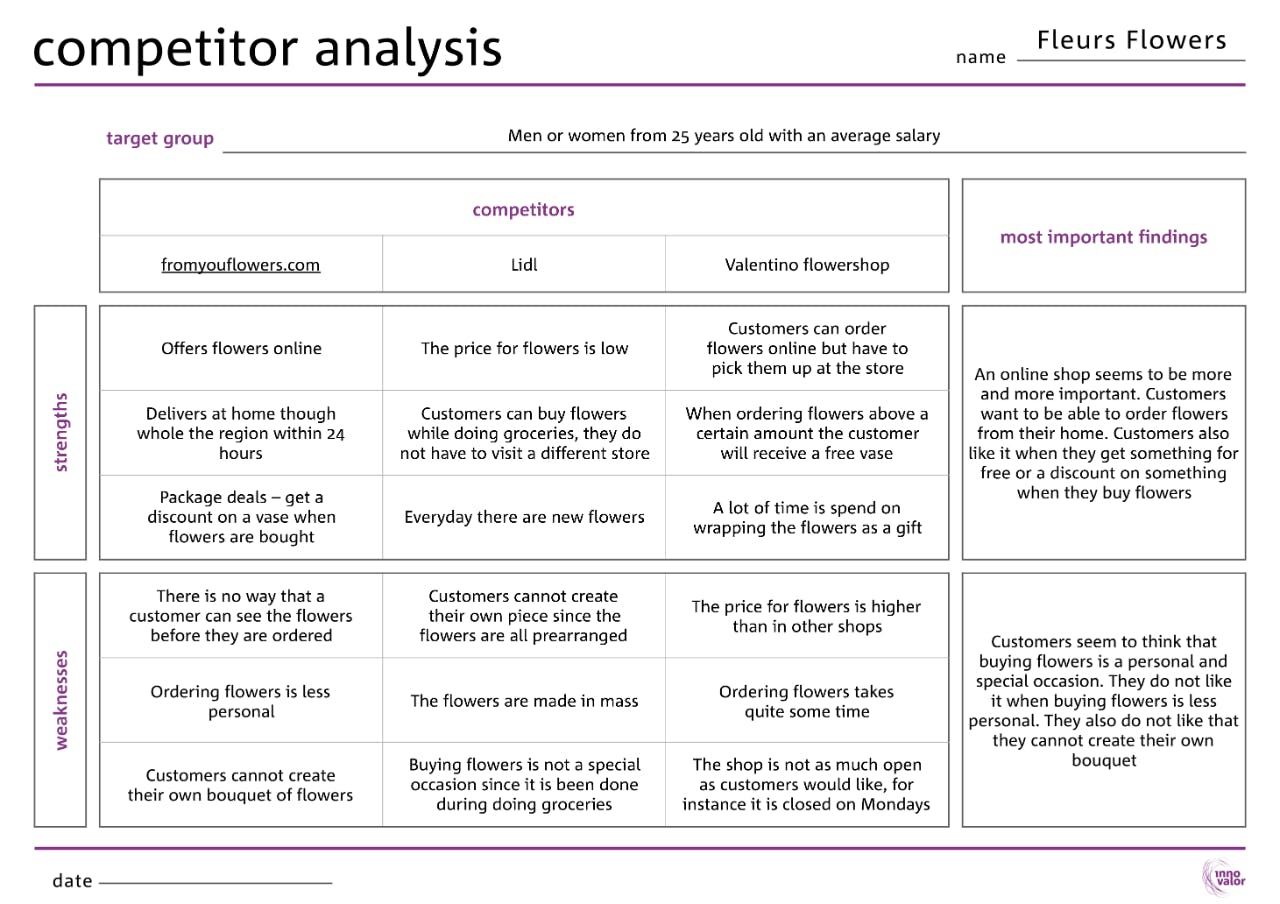
The table provides each competitor’s strengths, such as price, delivery options, the ability to order online, discounts, and gifts. Some weaknesses include problems with ordering, amount of time spent, lack of personalization, and other customer pain points. Finally, the table sums up the most crucial findings.
We can conclude that one of Fleurs Flowers’ competitive advantages is the ability to order flowers online. Furthermore, customers are interested in discounts or gifts, so it is a point for consideration. In addition, it is critical to make the process of creating a bouquet more personal. Thus, Fleurs Flowers offers the opportunity to create custom bouquets on their official website.
Every industry is competitive. Thus it's essential to be aware of the major players. However, you should keep in mind that as your company expands and changes, so will the competitors. While your direct rivals may cease to exist, your indirect competitors may take their place. Therefore, develop the practice of frequently examining other players on the market to keep up-to-date.
